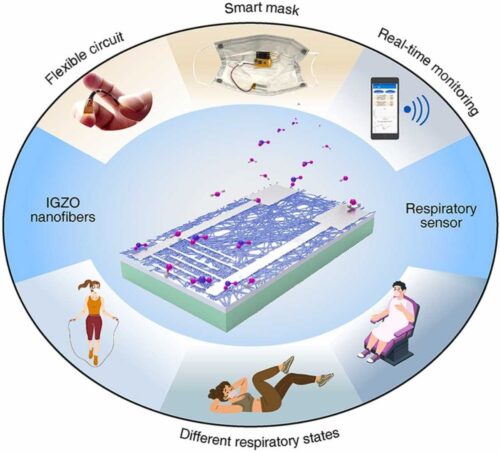Researchers from China and South Korea develop IGZO nanofiber-based sensors for enhanced respiratory monitoring.

A joint study by scientists from Southeast University, China and Chungnam National University, South Korea introduces an innovative sensor that leverages ultrathin amorphous indium gallium zinc oxide (IGZO) nanofibers to enable real-time, wireless monitoring of human respiration. Designed with a thickness of approximately 88 nanometres, this IGZO-based sensor marks a significant step in low-power gas sensing technology, particularly suited for applications in the Internet-of-Things (IoT) landscape, including smart wearables and mobile robotics. The technology is aimed at healthcare professionals, wearable tech developers, and organisations seeking pandemic-prevention solutions, due to its potential for immediate integration into respiratory health monitoring devices.
The sensor’s development responds to the limitations of traditional gas sensors, particularly in achieving reduced fibre diameter and enhancing real-time monitoring. IGZO nanofibers were engineered as a charge transport layer using an electrospinning technique, which improves the surface area for gas diffusion. As a result, the sensor’s field-effect properties demonstrated an average mobility of 2.2 cm²/V·s with an impressive on/off ratio of 10⁵, achieving both sensitivity and responsiveness.
The research team successfully tested the sensor’s performance across varying breathing patterns, such as fast, normal, and deep breaths. According to Qing Ma, lead author and postdoctoral fellow, School of Electronic Science and Engineering, Southeast University, “By integrating the sensor with a flexible circuit board and mounting them on a face mask, we achieved wireless and real-time monitoring of respiratory status, highlighting its potential for practical applications in health monitoring.” This adaptability makes it a valuable tool for both personalised healthcare and pandemic preparedness, particularly in wearable technology and mobile health applications.
Beyond breath pattern monitoring, the sensor’s conductivity is influenced by environmental factors such as oxygen levels, water vapour, and temperature. When a voltage is applied, the sensor’s current decreases with each exhalation and recovers as the breath cycle completes, with a rapid response time of approximately 0.7 seconds.
Binghao Wang, senior researcher and co-author, Southeast University remarked on the sensor’s broader potential, describing it as a “promising solution for pandemic prevention and personalised healthcare.” This breakthrough offers a practical and efficient means to monitor respiratory status, positioning the IGZO nanofiber sensor as a key advancement in smart health monitoring technologies.






